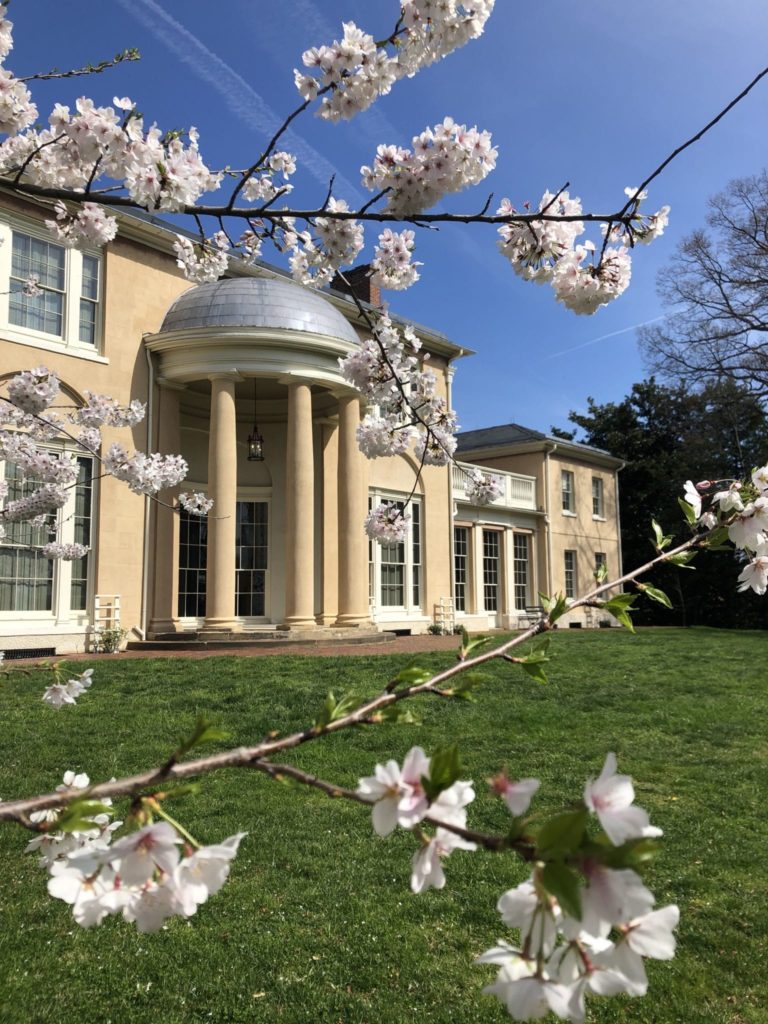Tudor Place, Historic Gem, Fully Reopens March 4
By • March 3, 2022 0 1605

Strolling up 31st Street towards Dumbarton Oaks, you may pass by another historic Georgetown gem without realizing it. Between Q and R Streets, glance over toward 32nd Street and you’ll see an elegant mansion set upon five and a-half acres of spacious grounds. You’ve just discovered Tudor Place at 1644 31st St. NW, ancestral home to six generations of the Peter family and a living museum to American and Georgetown history.
Designed by William Thornton, famed architect of the U.S. Capitol, St. John’s Episcopal Church (3240 O St. NW), and the Octagon House (17th & New York Avenue NW), Tudor Place is a classic Federal-style building fashionable in Georgetown’s early development. The Peters called this home for 178 years, from the presidencies of Thomas Jefferson to Ronald Reagan. Their lineage included a diversity of professions from mercantilism and medicine to finance, the arts and horticulture.
The mansion has a fascinating history. Marriage directly connected the Peters to our nation’s early heritage — specifically, George and Martha Washington and the Parke-Custis line — thus making Tudor Place Georgetown’s most direct link with the nearby Mount Vernon and Arlington House estates.
Upon receiving a handsome inheritance from her step-grandfather George, the “American Cincinnatus,” Martha Parke Peter (neé Custis, Martha Washington’s granddaughter), married Thomas Peter, a wealthy Georgetown merchant and financier. Martha Parke Peter’s inheritance enabled the couple to purchase the future Tudor Place property. Chosen for its prominent tract of land atop the “Rock of Dumbarton” (Georgetown Heights), the Peters chose Thornton’s symmetrical design of a central two-story block with adjoining connections to two pre-existing wings. Its beige stucco facade was a prominent feature of neoclassical architecture popular throughout the Mid-Atlantic region.
One of Tudor’s most unique features is a circular Romanesque columned portico that juts out from — and curves inward toward — the building’s elegant interior. Tall rectangular windows arrayed along this south-facing facade take advantage of Tudor’s lofty panoramic views. One can imagine the history that generations of the Peters family must have witnessed; from Georgetown’s growth as a thriving river port, to the burgeoning metropolis of a nation’s capital, to the rapidly developing hinterlands of Northern Virginia. Completed in 1816, Tudor Place resembles Thornton’s central core and adjoining wings design found with some of his other works.
Catalogued throughout the mansion are furnishings and accessories from two centuries of American history. Noteworthy items include two rare letters from Martha Washington to her husband — found in a desk inherited by Martha Peter — to furniture from the Gilded Age, a 1919 Pierce-Arrow automobile, and other period possessions up to the 1980s.
This continuum of Georgetown antiquity offers what Mark Hudson, executive director of Tudor Place, describes as a “a collection of heirlooms reflecting the generational passage from different eras.” These heirlooms represent preservation and change, signifying a unique distinction for a property that by 1960 would achieve national historic landmark status.
That prestigious award by the U.S. Department of Interior led Armistead Peter III, a sixth-generation descendant of Martha Parke and Thomas Peter, to negotiate a “permanent easement” with the National Park Service. A novel arrangement for its time, soon to be copied by other historic properties, this easement ensured Tudor Place’s preservation and maintenance in perpetuity as a working museum “for the benefit of the [nation] through the preservation of this site and inspiration of the people of the United States.” (“Tudor Place at 50,” by Mark Hudson, spring 2016 TPF newsletter.) Favorable timing on Mr. Peter’s part, for this arrangement coincided with passage of the National Historic Preservation Act of 1966. That landmark law ensured Tudor Place’s inclusion in a growing nationwide registry of protected sites, and provided additional insurance from development on or adjacent to the mansion and grounds.
Armistead [Peter, 3rd], a noted artist, historian, and horticulturalist, also launched the non-profit Tudor Place Foundation to work with NPS on property maintenance and managing operations for visitors, educators, and researchers. When he died in 1983, his widow moved just behind the mansion and gardens to Dower House, another 19th Century Georgetown jewel located on 31st Street. Following her death in 1995, TPF converted Dower House for administrative offices and meeting space.
Aided by a trove of historic documents the Peters left behind, the Foundation now sponsors programs that educate the public on architectural design, gardening, and the property’s unique history. This includes stories of enslaved people who worked on site or nearby, and their contributions to Georgetown’s development. Even with extensive records, the origin of Tudor’s name remains a mystery. As Mark Hudson says, “documentation on our name has not been found, but we will keep looking.”
As with other museums in the D.C. area, the pandemic suspended, then rearranged Tudor’s visitation schedules. During 2020’s initial shutdown, the mansion and grounds were closed from March to July.
The gardens reopened from August to November that year, while the mansion remained closed. Socially distanced self-guided and audio tours of Tudor’s first floor, conservatory, and gardens became publicly accessible from April to December 2021.
Tudor Place will reopen the full house and gardens to the public on Thursday, March 3, with guided tours of the first and second floors, and self-guided tours of the garden, from Thursdays through Saturdays. Self-guided tours of the house resume on Sunday, March 6.
For the latest details from Tudor Place, click here.

